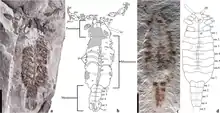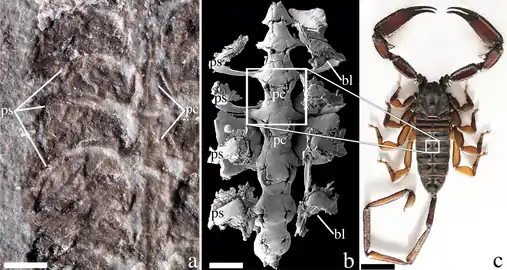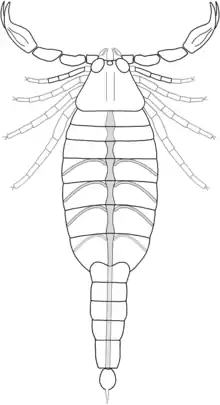Parioscorpio
Parioscorpio is an extinct genus of scorpion containing the species P. venator known from the Silurian aged Waukesha Biota of the Brandon Bridge Formation near Waukesha, Wisconsin. It is currently the world's oldest and basalmost known scorpion, older than Dolichophonus from Scotland by several million years. The fossils were originally discovered in 1985 but were neglected for decades. It is known from two specimens which preserve parts of the pulmonary, cardiovascular and digestive systems.
| Parioscorpio | |
|---|---|
 | |
| Scientific classification | |
| Kingdom: | Animalia |
| Phylum: | Arthropoda |
| Subphylum: | Chelicerata |
| Class: | Arachnida |
| Order: | Scorpiones |
| Genus: | †Parioscorpio Wendruff et al, 2020 |
| Type species | |
| †Parioscorpio venator Wendruff et al, 2020 | |

Description

The animal is around 2.5 centimetres long, It is characterized by a trapezoidal prosoma with large eyes located antero-laterally, and large pedipalps. Its mesosoma is much longer than the metasoma, it shows a record 7 tergites and 7 sternites. The 7 tergites is the highest known being progressively reduced in number in later stem-scorpions.
Paleoenvironment
How terrestrial the organism was is uncertain, as it was found in a shallow marine deposit, but it could have been transported into the environment from terrestrial sources.[1]
References
- Wendruff, Andrew J.; Babcock, Loren E.; Wirkner, Christian S.; Kluessendorf, Joanne; Mikulic, Donald G. (December 2020). "A Silurian ancestral scorpion with fossilised internal anatomy illustrating a pathway to arachnid terrestrialisation". Scientific Reports. 10 (1): 14. doi:10.1038/s41598-019-56010-z. ISSN 2045-2322. PMID 31949185.